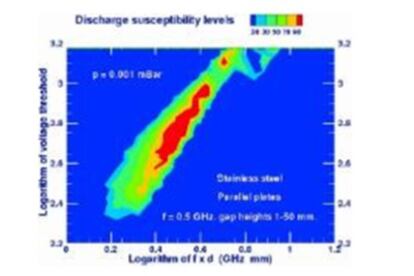Simulating discharge in communication satellites
The enormous cost of developing and placing a satellite in orbit must be recovered during its useful life
Communication satellites are complex instruments, whose systems and components must pass strict laboratory controls and tests. The enormous cost of developing and placing a satellite in orbit must be recovered during its useful life, providing the greatest possible range of services (television, telephony, Internet, etc.) with the greatest possible number of independent channels.
The growing demand for services means that components must be miniaturised and the number of operative frequencies increased. To service larger areas of the earth's surface and a greater number of users, the strength of the radio frequency transmitted must be high, creating ideal conditions for the formation of unwanted destructive discharges: intense microwave electric fields inside small spaces within the satellite's communication system. Similar circumstances can be found in other complex systems using microwaves, such as particle accelerators or semiconductor materials processing equipment.
Microwave systems used in communication satellites must operate under extreme conditions with high-strength radio frequency. Their communication performance must be optimal and the possible appearance of destructive discharges must be predicted. A group of researchers at the Autonomous University of Madrid (UAM) is currently working on numerical simulations that predict the formation of destructive discharges. Numerical simulations save the costs of testing laboratory equipment and give designers extremely useful information on the limits and operating conditions of the equipment.
Electric discharges consist of multiple charges. The two basic processes caused by microwaves are called multipactor and corona discharges. The first occurs at very low gas pressures (typically below 10-5 mBar), when electrons, accelerated by the electric field of the microwave, impact a surface (metallic or dielectric), causing emission of a new secondary electron. Multipactor discharge is caused by this repeated multiplication of secondary electrons, with the properties of the materials playing a crucial role. Corona discharge occurs at very high pressures (above 10-2 mBar) because of ionisation of the residual gas filling the device, with the properties of the materials also playing a crucial role. Between both pressure bands, there is a transition zone where both charge multiplication mechanisms exist, called multipactor collisional.
Three members of the GHIA group from the Department of Computer Engineering of the UAM, in collaboration with Professor Luis Conde of the Universidad Politécnica de Madrid (UPM) and David Raboso of the European Space Agency, have recently published a paper in PHYSICAL REVIEW E reporting on multipactor and corona discharge prediction in wave guides through simulation. Specifically, their system can be used in the transition pressure range, where until now simulation tools have been unavailable, and the results obtained for low and intermediate pressures have been validated with experimental data published in the scientific literature.

Tu suscripción se está usando en otro dispositivo
¿Quieres añadir otro usuario a tu suscripción?
Si continúas leyendo en este dispositivo, no se podrá leer en el otro.
FlechaTu suscripción se está usando en otro dispositivo y solo puedes acceder a EL PAÍS desde un dispositivo a la vez.
Si quieres compartir tu cuenta, cambia tu suscripción a la modalidad Premium, así podrás añadir otro usuario. Cada uno accederá con su propia cuenta de email, lo que os permitirá personalizar vuestra experiencia en EL PAÍS.
¿Tienes una suscripción de empresa? Accede aquí para contratar más cuentas.
En el caso de no saber quién está usando tu cuenta, te recomendamos cambiar tu contraseña aquí.
Si decides continuar compartiendo tu cuenta, este mensaje se mostrará en tu dispositivo y en el de la otra persona que está usando tu cuenta de forma indefinida, afectando a tu experiencia de lectura. Puedes consultar aquí los términos y condiciones de la suscripción digital.
Archivado En
Últimas noticias
La obsesión de Trump por poner su nombre a todo carece de precedentes en Estados Unidos
Egipto intensifica las detenciones de ‘influencers’ considerados indecentes
Correos sube un 7,9% los sellos nacionales y un 5,5% los paquetes para 2026
Mueren un hijo menor y su padre intoxicados por humo en una vivienda de un pueblo de Palencia
Lo más visto
- Los ‘whatsapps’ de Mazón a Feijóo del día de la dana: “Un puto desastre va a ser esto presi”
- La revalorización de las pensiones queda en el aire por la negativa de la derecha a apoyar otras medidas sociales
- Juan Carlos Ferrero: “Más que dolor, siento pena; los finales siempre son tristes”
- El líder groenlandés responde a Trump: “Groenlandia es nuestro país. Nuestras decisiones se toman aquí”
- Zelenski confirma que cualquier pacto con Rusia deberá ser ratificado en referéndum




























































